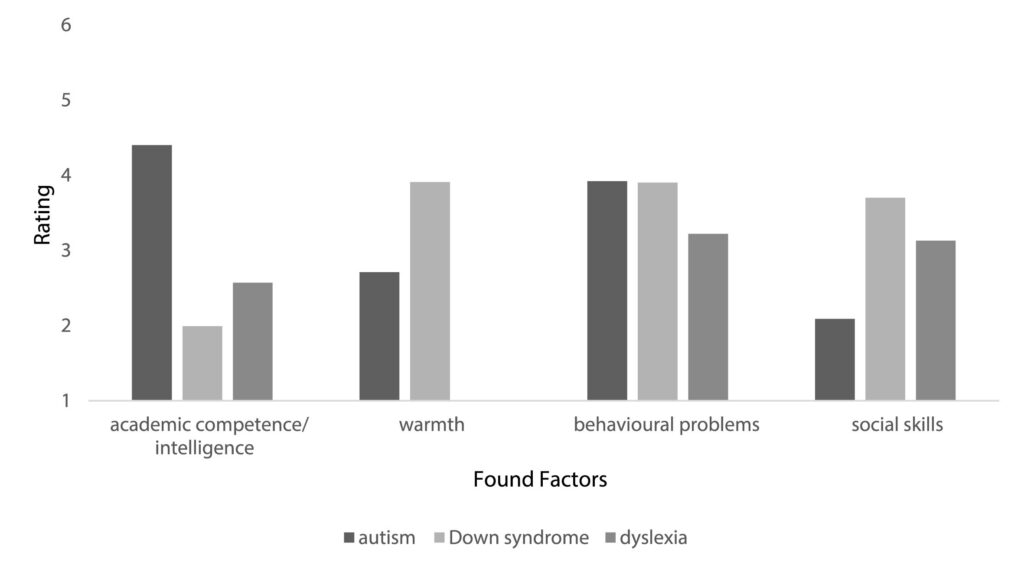Comparison and evaluation of the detected dimensions for all three student groups. credit: Education and teacher education (2024). DOI: 10.1016/j.tate.2024.104526
× close
Comparison and evaluation of the detected dimensions for all three student groups. credit: Education and teacher education (2024). DOI: 10.1016/j.tate.2024.104526
In the process of inclusion, teachers are increasingly teaching students with special educational needs. Stereotypes about these children and adolescents can influence how teachers treat them. DIPF | Leibniz Institute for Educational Information conducted a survey to find out how current teachers imagine students with autism, Down syndrome and dyslexia.
This research Education and teacher education, significant stereotypes were revealed among in-service teachers, such as how competent and warm individual student groups were. DIPF wants to develop educational programs to counter such generalizations.
“Students with autism are perceived as particularly competent but less warm; students with Down syndrome are perceived as particularly warm and less competent; students with dyslexia are perceived as less competent and relatively less warm.” '' says Charlotte Schell, lead author of the paper.
By comparison, students with autism were perceived as the most competent but least warm, and children with Down syndrome were perceived as the most warm but incompetent. Children and adolescents with dyslexia were the focus of comparison in each case.
A number of individual stereotypes mentioned by pre-service teachers were systematically incorporated into the overarching categories of 'competent' and 'warm'. Some of these diverse attributions were particularly far-reaching. “For example, in-service teachers were more likely to believe that students with autism were talented and introverted, students with Down syndrome were good-natured and clumsy, and students with dyslexia were lazy and underachieving,” Shell said. He explains.
Even if such stereotypes apply to individuals, they are too generalized and ignore individual differences among students. “It's not enough to put all students in the same box. Students have specific behaviors and abilities that are very different from each other, so students need individualized support,” Shell says.
For example, if a teacher determines that a child is highly intelligent or even highly gifted, based on an autism diagnosis, the teacher may overlook the child's needs and not provide sufficient support. there is. After all, many autistic students are not gifted. Conversely, if children with dyslexia are stereotypically seen as lazy, teachers may ask them to work harder instead of providing targeted support tailored to their needs.
scientific investigation
For the study, the DIPF team worked with in-service teachers who were at different stages of their studies, taking different subjects and studying different school types. As a preliminary study, the researchers first interviewed 13 of these students and asked them to list stereotypes associated with the groups mentioned. This revealed a wide range of attributes, such as impulsive, low intelligence, but also open or wise.
The researchers incorporated the results of the first study into a standardized questionnaire to document the empirical characteristics of stereotypes regarding the three student groups. A total of 213 in-service teachers completed this survey in her second, larger study. The strengths of individual attributes were then treated statistically and assigned to overarching categories using factor analysis.
Implications and further research
This study was conducted as part of the research project “Stereodiscs—stereotypes that impede professional diagnosis in inclusive school environments.'' As part of the project, DIPF is developing an educational program for teachers to reduce the impact of stereotypes on the assessment of children with special educational needs. For example, seminars that deepen knowledge about the educational needs and diagnostic skills of individual groups. Current research highlights the need for such programs.
For future research, the researchers developed a model for how to better structure individual stereotype attributions. Based on their research, they recommend classifying them into the following categories: academic ability, warmth, social skills, and behavioral problems.
Schell emphasizes that further research on this topic would be helpful. “We only investigated stereotypes in pre-service teachers, and we only targeted three groups of students with special needs,” said the DIPF researcher. The project team is also currently looking more closely at the influence of stereotypes on behavior.
For more information:
Charlotte S. Shell et al. Do you judge a book by its cover? Investigating in-service teachers' stereotypes about students with special educational needs; Education and teacher education (2024). DOI: 10.1016/j.tate.2024.104526
Provided by: Leibniz-Institut für Bildungsforschung und Bildungsinformation


